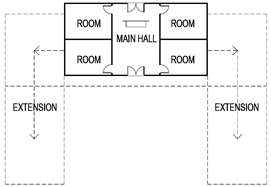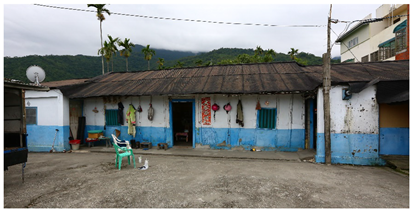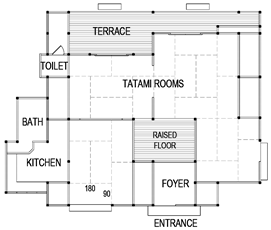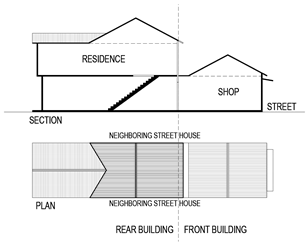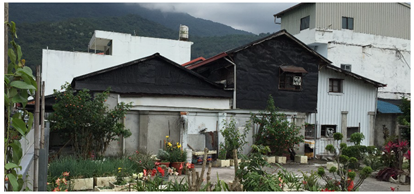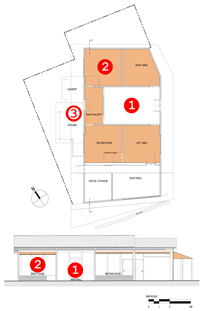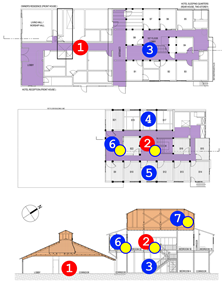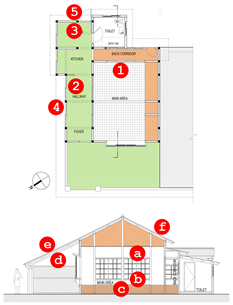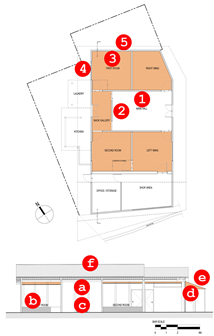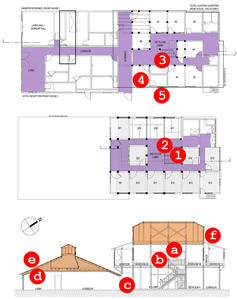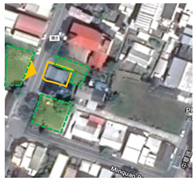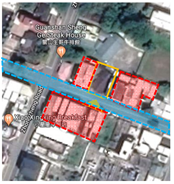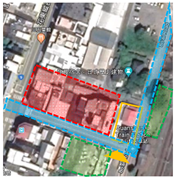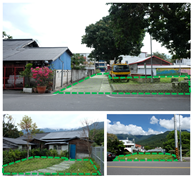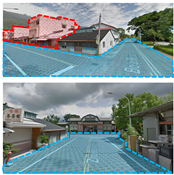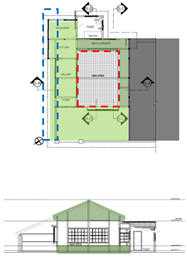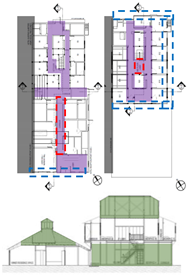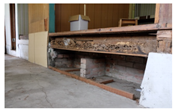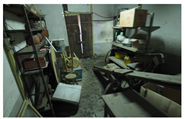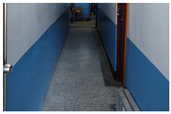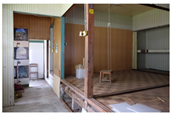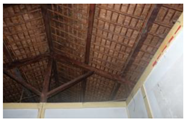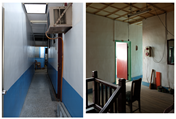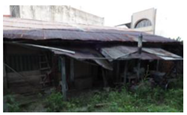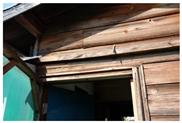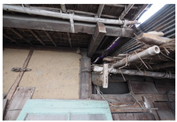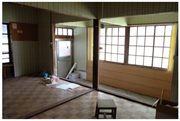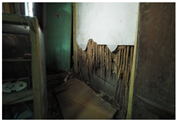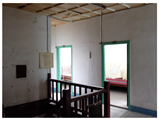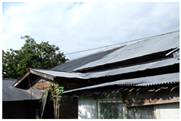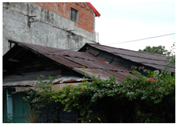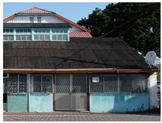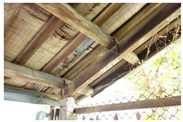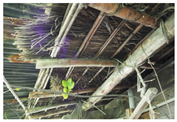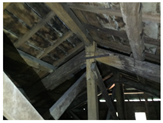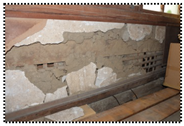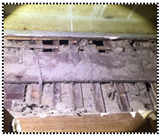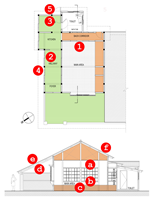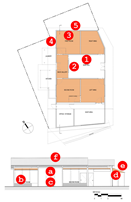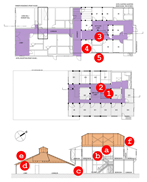Abstract
The paper presents a comparative study of the climate responsive design strategies and indoor thermal performance of three vernacular houses in Guanshan Township of eastern Taiwan by building survey and instrument measurements. These houses are all about 80 years old. They are of Chinese style, Japanese style, and a mixture of both styles. All three houses are popular building types in the region. Key findings include: (1) Space buffer, thermal insulation, ground exposure, and natural ventilation are the key elements of climate responsive design strategies. (2) The climate responsive design strategies of the three buildings, while using similar building material, are not the same. They are strongly associated with the buildings’ cultural roots as well as the buildings’ use patterns. (3) The Chinese-style house is a heat rejecter. It is comfortable in spring and summer. The mixed-style house is a heat keeper. It is comfortable in winter and spring. The Japanese-style house is well-ventilated and has equal thermal comfort level at around 50% in all seasons. It is uncommon that vernacular buildings from different cultural traditions coexist in the same region. This study provides detail appraisals of their respective sustainable design strategies in hot and humid climate.
1. Introduction
Various studies have shown that vernacular architecture consumes less energy and leaves little environmental impact to achieve good indoor thermal comfort [1,2,3,4,5,6,7,8,9,10,11,12,13,14]. Vernacular architecture has much to offer modern sustainable architectural design [15,16,17,18,19,20,21]. A key characteristic of vernacular architecture is its location-specific climate-responsive design strategies [22,23,24,25,26,27]. Where there are more than one type of vernacular architecture thriving in the same region, the questions of “what are the differences and which provides better thermal comfort” naturally arise. The questions are quite relevant since sustainable development often takes lessons from vernacular traditions.
This paper presents a comparative study of climate-responsive design strategies and the indoor thermal environment for three vernacular houses in Guanshan in the Huatung Valley of eastern Taiwan. All three houses were built circa 1940. One house follows the Chinese dwelling style, another house follows the Japanese dwelling style, and the third house is a mixed-style street house. The research objectives are to associate the design strategies of each house with the characteristics of the thermal performance.
Until the early 17th century, Taiwan was home to only aboriginal tribes without a central political system. During the ruling of Imperial China (1675–1895) and Imperial Japan (1895–1945), the culture, language, economy, and social-political system of the respective ruling regimes were introduced to Taiwan and fundamentally reshaped Taiwanese daily life [28,29,30]. Foreign-turned indigenous vernacular architectural styles from China and Japan coexist in many parts of Taiwan. Like Taiwan itself, southern China and southern Japan are both situated in the “humid and subtropical” climate zone [31]. However, traditional Chinese and Japanese buildings were designed with different architectural characteristics [32,33,34,35]. Several studies of traditional Chinese and Japanese buildings have been conducted in their respective homelands for the building’s thermal performances [1,2,3,4,5,6,7]. However, cross-comparisons of the performances of the vernacular building types from China and Japan are seldom observed in Taiwan.
The research goals for these three types of vernacular structures in Guanshan are as follows: (1) Identify their respective climate-responsive strategies. (2) Assess the performance characteristics of the respective indoor thermal environment by means of on-site monitoring. (3) Investigate the effectiveness of passive design strategies for their respective use pattern and solicit knowledge that can be applied in modern architectural design.
2. Overview of Guanshan Township
2.1. Brief History
The 150 km strip of Huatung Valley was occasional hunting grounds for the Bunun and Amis tribes from the mountains. The first settlements in the valley were established in the late 19th century by the rice-farming Pinpu Tavoan tribe from southern Taiwan. Guanshan was the southernmost post of the tribe’s settlements. In 1915, the Japanese colonial government established the Guanshan Township to control aboriginal Taiwanese and develop the valley’s nature recourses. During Japanese ruling, waves of ethnic Chinese were recruited from western Taiwan. They helped to construct the eastern railway and develop the agricultural and forestry industries. By the 1940s, the majority of Guanshan’s population was of Chinese ethnicity [36].
2.2. Settlement Pattern
In 1924 (Figure 1), the Japanese-designed grid plan [37] replaced the original one-road settlement of the Pinpu people and guided the development of Guanshan over the subsequent 90 years. The grid plan was centered on the east-west running railway station/police station axis. Along the axis are the buildings for regional political/commercial activities. The north of the central axis is the axis of daily life that evolved from the old Pinpu settlement. The public school, market, shops, theater, and Sea Goddess Temple are all in this district. The southern area of the central axis is the residential sector for government officials. The area was outside the original Pinpu settlement. In the north-south direction, supporting facilities such as warehouses and railway dormitories were built along the railway. Government officials’ residences were built along the side of the police station.
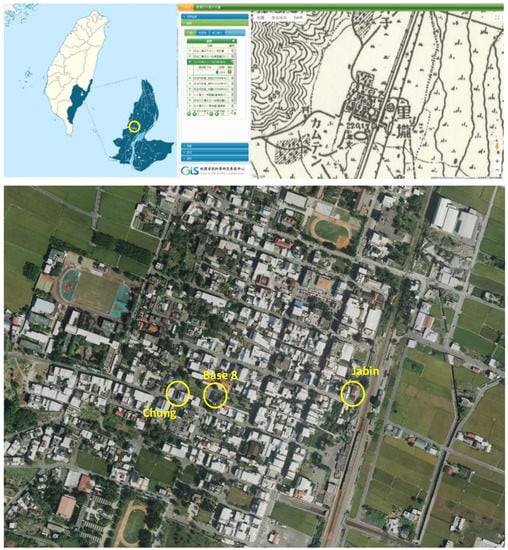
Figure 1.
Regional and street map of Guanshan [37].
2.3. Climate and Topography
The collision of the Eurasian plate and the Philippine Sea plate created the Central Mountain, the Coastal Mountain, and the in-between Huatung Valley. Guanshan (120° E longitude, 23° N latitude) is approximately 225 m above sea level. The average temperature is 27 °C in July and 16.7 °C in January. On a daily basis, the daytime temperature can reach above 35 °C in summer, while the nighttime temperature can drop below 10 °C in winter. The annual precipitation, mostly concentrated from July to October, is approximately 1800 mm. The average wind speed is higher in winter (close to 2 m/s) and lower in summer (less than 1 m/s) [38]. The specific topography results in a hot and humid climate pattern with a higher degree of fluctuation (Figure 2).
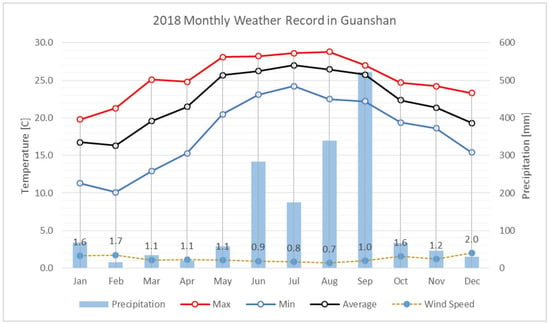
Figure 2.
Guanshan weather station record [38].
2.4. Distribution of Vernacular Structures
Three types of structures are commonly seen in Guanshan (Table 1): Chinese-style residences, Japanese-style residences, and street houses. Chinese-style residences were brought by immigrants of Chinese ethnicity as farmers’ houses. These dwellings are scattered around Guanshan. Japanese-style houses dwell in clusters in the central area of town. The occupants of the Japanese-style houses were families of salaried workers with special skills, such as railway clerks, police, and teachers. People in the same institution live in the same dormitory cluster. As the town booms, the business-orientated immigrants gradually caught up with the agricultural and institutional immigrants. They built shop houses on the streets in the central town. The structures are privately owned but are side-by-side with shared walls. Part of the structure is for residence, and part of the structure is for business. Vernacular buildings in Guanshan all use similar construction materials (wood, bamboo, weed, and soil). Most of these materials are locally available with minimal carbon footprint. It is noteworthy that brick and adobe constructions are not present in Guanshan. Walls of vernacular houses are all lightweight constructions.

Table 1.
Building typology in Guanshan.
2.5. Building Typologies
2.5.1. Chinese-Style Residence
Traditional Chinese structure [32,33] is described by Jian (bay), a measure of width, and Jia, referring to the depth of the room. In dwellings, Jian also implies a space flanked by walls on both sides. A basic house plan is a horizontal I-shape divided by three bays under a pitched roof. The doorway is in the central hall of this three-bay dwelling. The central hall is the living space with an ancestor worship alter. This area is usually furnished with a clove, table, and chairs. The central room is linked to adjacent bedrooms on either side by the interior doorway. A Chinese dwelling size can be increased first by attaching additional rooms to the sides of the original structure, and then by adding side wings perpendicular to the original I shape of the building, forming a symmetrical square building layout with a closed or semi-open courtyard in the center. The square-shaped building layout is duplicated along the central axis if the population is further expanded. In rural areas, building materials are flexible according to local availability. The windows are usually limited in size and sealed since most activities occur outside of the bedrooms.
2.5.2. Japanese-Style Residence
Traditional Japanese houses [34,35] are post-and-beam wooden structures with sloped roofs and large bay windows. The floor plans are flexible. These houses have elevated floors and flat ceilings with few fixed walls. To keep the house clean, shoes are removed and stored in the vestibule. Interior partitions were made of removable lightweight sliding doors. The sliding doors are open during the day and closed at night. The elevated floors are covered by straw-matted tatami sheets. The tatami sheets, roughly 180 cm by 90 cm, modulate the floor. The tatami rooms are multipurpose. Each room has a cupboard to store a futon mattress. Tatami rooms adjoin, so a large space can be created when needed. Similar to Chinese houses, the kitchen, bath, and toilet of a Japanese house are placed on the outskirts, either attached to or detached from the main structure. Light construction, open floor plan, and porous envelopes all encourage the Japanese house to induce natural ventilation.
2.5.3. Mixed-Style Street House
The street houses in Guanshan often comprise two parts: the front part is a one-story structure facing the street, and the rear part is a two-story structure with a large window on the second floor for ventilation and daylight. The construction is similar to a Japanese-style house; however, the appearance does not resemble a traditional Japanese street house [39] with a front part that is usually two stories. The layout is also unlike that of a traditional Chinese street house [40,41] because there is no courtyard between the two sections. For well-to-do owners, the front part is wider with two bays: one for business and the other for a residential entrance. For a modest homeowner, the front part is a single bay and is only used for business. The residence is in the rear section. The two-section typology of the street house allows each section to be renovated or rebuilt independently, which allows for a variety of two-section combinations to be developed in Guanshan.
3. Materials and Methods
The comparative study was carried out in two folds: (1) Qualitative analysis based on conventional building survey, and (2) Quantitative assessments of the indoor thermal environments by environmental sensors (Figure 3).
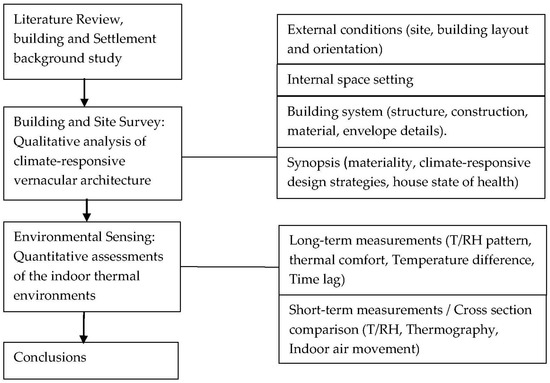
Figure 3.
Research workflow.
3.1. Qualitative Analysis of Climate-Responsive Vernacular Architecture
The building survey focused on three areas: (1) External conditions (site, building layout, and orientation); (2) Internal space setting; (3) Building system (structure, construction, material, and envelope details). The synopsis was then drawn to summarize the materiality, the climate-responsive design strategies as well as the state of health of the vernacular architecture.
3.2. Quantitative Assessments of the Indoor Thermal Environments by Environmental Sensors
The measured variables include air temperature, relative humidity (RH), surface temperature, and air movement. Due to constraints in resources and building accessibility, long-term and short-term measurements were conducted with different levels of detail (Table 2 and Table 3).

Table 2.
Placements of temperature/humidity sensors and anemometers in the buildings.

Table 3.
Measured surfaces of infrared thermography in the buildings.
Long-term measurements were used to capture the overall trend in the indoor thermal environment. Two to three HOBO temperature/RH data loggers (Models: MX1101, MX2300) were installed in each house: one in the circulation area (walkway) and one in the living area. The physical characteristics of the two areas are differentiated by the ground and elevated floor. The third temperature/RH data logger was installed in a shaded area outside the house for ambient reference. The instruments were installed at a height of 1.5 m. Data for one week were extracted from the winter, spring, and summer measurements.
Short-term measurements were aimed to extract the characteristics of the individual building components. For a period of one month, the Base 8 house and Jabin hotel were installed with additional HOBO sensors to record the temperature/RH fluctuations in multiples spaces. For the Jabin hotel, the measured spaces include the ground floor hallway, second-floor landing, balcony, a single room, Japanese rooms, the attic in the rear building, and the hallway in the front building. For the Base 8 house, the spaces include the hallway, living room, crawl space, attic, and outdoor shaded porch. For the Chung house, the measured spaces are the same: main hall, bedroom, and shaded outdoor area.
Surface temperature measurements [42] were taken by an infrared camera (FLIR Model E8) in the morning, afternoon, and early evening in August and April. Thermal images were obtained for the roof, ceiling, interior and exterior surfaces, and floors. The thermal insulation, buffer effect and heat storage capacity were observed.
Anemometers (RM Young Model 81000 with Campbell Scientific CR1000X data logger) were installed in the Base 8 house next to the HOBO data loggers in the hallway and living room for approximately two weeks. They were then moved to the Jabin hotel and installed in the balcony, second-floor sitting hall, and attic of the rear building for another two weeks of recording. The experiment is to elicit the air movement pattern and compare it to the building’s design strategies.
4. Qualitative Analysis of Climate-Responsive Vernacular Architecture
All three houses were built between 1930 and 1940 in the urbanized street grid. The Chung house is a Chinese-style house. The Base 8 house is a Japanese-style house. The Jabin hotel is a mixture of both styles. Their characteristics are summarized in Table 4 and Table 5.

Table 4.
Building constructions (building sections, wall details).

Table 5.
Design strategies (site, space layout, building envelope).
4.1. Chung House
4.1.1. Site, Building Layout, and Orientation
The Chung house is flanked by two-story street houses on the eastern and western sides. The building is shaded from direct sunlight the majority of the time. The southern (right) side of the building is adjacent to the street and runs east-west. The northern (left) side is adjacent to the yard of another traditional Chinese residence. The building has strong characteristics of a Chinese dwelling: a one-story structure with a three-bay horizontal I-shaped layout and a shed attached to the right wing. Built before the urban development of this area, the structure is tilted approximately 30 degrees from the street grid. The front door faces east and the back door faces west. The triangular strip between the front door and the neighboring building is a garden. The unbuilt area on the backside of the building is also covered by vegetation.
4.1.2. Internal Space Setting
The partitions of the interior space follow Chinese tradition. The central bay main hall serves as an ancestral worship and living space. There is a small chamber in the back to separate the back door and main hall. Both wings have two bedrooms. All rooms are accessed through the central bay main hall. The bedroom in the upper right corner has another door connected to an additional large room. The large room has a large scrolling door that opens to the street. All rooms have drop ceilings with the exception of the main hall, which has an exposed roof. The main hall has an exposed ground floor. The bedrooms have elevated floors that also serve as bed decks. In terms of dimensions, the width of a bay is approximately 3.65 m. The depth of the house is approximately 7.30 m. The wall height is approximately 2.75 m, the ceiling height is approximately 2.6 m, and the height of the roof ridge is approximately 4.10 m.
4.1.3. Building System
The corrugated metal plate-covered thatched roof is built on top of the bamboo roof frame. The thickness of the existing straw layer is approximately 20 cm. The bamboo and straw are visible from the hall beneath the roof. There is no roof vent. The wall structure comprises a post-and-beam wooden frame with woven weeds and mud wall infill. Each bedroom has a wooden sliding grill window (no glass pane) with a small opening. There are wooden double doors on the front and back of the main hall. The extended right wing faces the street. The scrolling doors can be fully opened. The extended wing functioned as a small grocery store. Attached to the extension is a porch, which provides a buffer area between the street and grocery store.
4.1.4. Synopsis
Under the thatched roof, the climate-responsive components are as follows: For the bedroom, the raised floor, ceiling, and small windows create an air-buffered space for sleeping during nighttime. For the main hall, the no-ceiling high roof encourages air circulation with a cooling effect from the exposed ground to facilitate daytime activity. For the grocery store addition, the wide-open door and porch encourage maximum ventilation while avoiding direct exposure to the sun. With the exception of the roof top metal plate, the building is mostly the original structure from the 1930s.
4.2. Base 8 House
4.2.1. Site, Building Layout, and Orientation
The rectangular plot of the Base 8 house runs east-west. The plot follows the orientation of the street grid. The northern side of the plot is adjacent to a vegetated land strip. The southern side is the other half of the building duplex. The western (front) side faces the street. The eastern (rear) side is a small garden. The building has strong characteristics of a Japanese dwelling: one story duplex with a pitched roof, large bay windows, open floor plan, sliding doors, dropped ceiling, and elevated floor. Because there are no tall structures nearby, the roof is directly exposed to sunlight.
4.2.2. Internal Space Setting
There is no fixed partition within the interior space. Two adjacent square-shaped rooms with cardboard, the main and secondary corridors, are all part of the open plan. The open spaces have dropped ceiling and raised floors. Between these spaces are tracks for sliding doors that define the spatial boundary. At the end of the main corridor, a shed is attached. This shed accommodates the kitchen and bathroom. The main corridor used to have an elevated floor but was converted to a ground floor by Taiwanese residents after the Second World War. The size of the interior space is 6 m by 6 m. The size of a room is 3.6 m by 3.6 m. The height from the raised floor to ceiling is 2.2 m.
4.2.3. Building System
The corrugated metal plate replaced the roof tile after the Second World War. Beneath the metal plate is the wood backing supported by the wood trusses. The wood trusses are supported by a post-and-beam system in the occupied spaces. There is a vent hole for the crawl space under the elevated floor. The attic is shared by both housing units of the duplex. Louvered vents are on both pediments under the roof ridge. Thick mats were laid on top of the ceiling to improve sound insulation from the adjacent neighbor. The wall is covered by wood siding on the outside and uses bamboo strip grid and mud as the wall infill. Different from that of the Chinese-style residence, there are voids between the bamboo strips, allowing the mud infill on both sides to bind together. There is almost no air gap between the roof and walls. There is a large bay window in the front room open to the porch. The porch and the fencing wall were both added after the Second World War, creating a semi-open outdoor space between the street and house. The sliding window runs through the entire length of the corridor. Both the front door and back door are connected to the main corridor. A new elevated floor was added to the corridor during the later period of the investigation.
4.2.4. Synopsis
The raised floor and the attic space created buffers from direct sunlight and from ground moisture. The open plan and very high window to wall ratio maximize the natural ventilation and utilization of daylight. These strategies imply that the daytime usage of the house is important. Fresh air plays a key role in the indoor thermal comfort.
In addition to the metal roof plate and porch additions, the building is mostly the original structure of the late 1930s. Material damage occurred only on the corridor’s wall beneath the window and on the low beam of the elevated floor. Both damage incidences can be attributed to the accumulation of humidity from rain and ground moisture. Overall, the structure is in good condition, proving the durability of the once-foreign vernacular form.
4.3. Jabin Hotel
4.3.1. Site, Building Layout, and Orientation
The fully built rectangular plot of the Jabin hotel runs north to south. The building is at the corner of the street block. The northern, eastern, and southern sides are surround by roads. Only the eastern side is adjacent to the neighboring building. The Jabin hotel consists of two connecting structures. The front structure is on the southern side. It is a one story building with a gable roof and roof dormer. The back structure is two stories with a jerkin head roof. Behind the front building, there is a semi-open space, above which the balcony protrudes from the back building. The roof ridge of the rear structure and that of the front structure are perpendicular. Both roofs are directly exposed to sunlight. The building has characteristics of both Japanese and Chinese dwellings, which is detailed in the following sections.
4.3.2. Internal Space Setting
The walkway of the front building divides the space into two parts. The eastern half is a hotel lobby and suites, and the western half is the owner’s residence. Dormer roofs provide ventilation and daylight from above. The back building has a U-shaped grand staircase in the center. A walkway connects the stairs to the in-between space of the two buildings and to the back door. Hotel rooms surround the grand staircase. The standalone bathrooms and toilets are at the back of the building. On the first floor, the rooms are traditional Chinese-style rooms with beds standing on the ground. On the eastern side of the second floor, there are three Japanese tatami rooms. These rooms can be merged into one large unit by retracting the sliding doors. The sitting area on the second floor is sizable and is often used as a living room by the premium guests of the Japanese rooms. All other non-Japanese rooms have windows for daylight and ventilation. There is a ceiling on the second floor. There is an attic between the roof and ceiling. Both the front and back buildings are approximately 10 m by 10 m in footprint (Table 4 and Table 5).
4.3.3. Building System
The walls of the front building, rebuilt in the 1980s, are made of reinforced concrete. The roof and dormer, covered by metal sheets, are wooden structures. The back building is a wooden post-and-beam structure. The exteriors of the two street-facing elevations are covered by metal with original wood siding underneath. The wall infill is made of either a Japanese-style bamboo strip grid and mud or wood lath. The interior is finished with plaster. There are glass windows on the exterior walls. The roof-covered second-floor balconies protrude from the front and back of the structure. There are rooms on both sides of the balcony. The roof is supported by an industrial scale wood truss structure. Originally, there were roof tiles over the wood backing. The tiles were later replaced by metal plates.
4.3.4. Synopsis
The Jabin hotel employs different climate-responsive strategies in different parts of the building. In the front building, a large roof dormer is used for daylight and ventilation. On the first floor of the rear building, the spatial characteristics are similar to those of the main hall in the Chung house. The first floor is heavily shaded from direct sunlight and uses ground cooling to reduce room temperature. The second floor of the rear building employs strategies similar to those of the Japanese-style house. Two fully open-door casings to the balconies allow cross ventilation to occur at any time of day. The thermal buffer zones from the attic, side units, and first floor provide a stable thermal environment free from the effects of direct sunlight and ground moisture. The walls of the front building were rebuilt in the 1980s. The structure of the back building has remained unchanged since 1940.
5. Quantitative Assessments of the Indoor Thermal Environments
5.1. Long-Term Measurements
The analysis of the long-term monitoring data focused on three areas: (1) The patterns of temperature and humidity fluctuations and comfort percentage (Figure 4). (2) The difference between outdoor and indoor temperatures (Figure 5). (3) The time lag between the extreme outdoor and indoor temperatures (Figure 6). Together, they provide key appraisals of the thermal performance of the three climate-responsive design strategies.
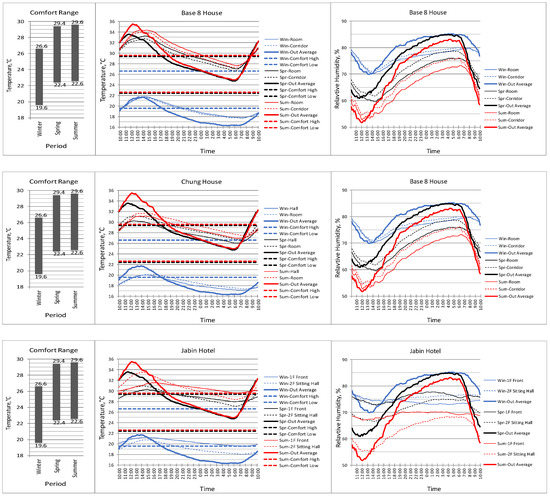
Figure 4.
Seasonal temperature, humidity, and comfort percentage (averaged from each period).

Figure 5.
Temperature difference (seven-day average, time periods as Figure 4).
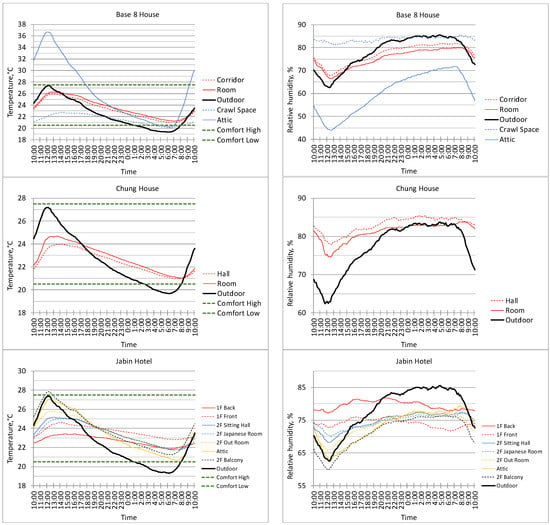
Figure 6.
Temperature and relative humidity short-term measurement (average from 25 March 2019 to 31 March 2019).
5.1.1. Patterns of Temperature and Humidity Fluctuation and Comfort Percentage
Winter season monitoring data were obtained between 22 January 2018 and 29 January 2018. Spring season monitoring data were obtained between 14 May 2018 and 21 May 2018. Summer season monitoring data were obtained between 6 August 2018 and 13 August 2018 (Figure 4).
For all three seasons, the Base 8 house indoor temperatures always fluctuated the most. The Jabin hotel temperatures fluctuated the least. It demonstrates a highly consistent pattern (Table 6).

Table 6.
Temperature and relative humidity range from long term measurements.
For the relative humidity levels of the three houses, the Base 8 house has the lowest humidity, and the Chung house has the highest humidity for all three seasons. The results correspond well with the openness of the Base 8 house and the closedness of the Chung house building envelopes (Table 6).
The percentage of time the three vernacular buildings achieving thermal comfort is calculated based on the comfort temperature range of the Adaptive Comfort Model in ASHRAE Standard 55-2017 [43] (Table 7).

Table 7.
Percentage of comfort period from long term measurements.
The Jabin hotel performed best in winter, well in spring, and worst in summer. The Chung house performed best in spring, well in summer, and worst in winter. The Base 8 house is the most consistent across seasons with a moderate level of comfort. In all seasons, there is at least one house performing better in thermal comfort than the outdoor condition.
5.1.2. Temperature Difference
During all seasons, the indoor living area temperatures of all three houses are lower in the daytime and higher in the nighttime compared to the outdoor temperatures, indicating the effectiveness of all three climate-responsive designs (Figure 5).
In winter, the Chung house is the coldest in both night and day. The Jabin hotel is the warmest in the night. The Base 8 house is the warmest in the day.
For the spring and summer periods, the Chung house is the coldest in the night. The Jabin hotel is the warmest in the night. The Base 8 house is the warmest in the day.
In summary, the Jabin hotel is always the warmest and the Chung house is always the coolest at night. The Base 8 house is always the warmest at day.
5.1.3. Time Lag
The time lag is the time between the highest/lowest outdoor temperatures to the highest/lowest indoor temperatures (Table 8). This measurement is an indicator of the combined effect of a building’s heat capacity and conductivity.

Table 8.
Time lag (seven-day average, time periods as Figure 4).
In a comparison of the three season periods, spring has most of the highest time lags for all three houses during the daytime, whereas winter has the highest time lags for all three dwellings during the nighttime. The time lags of these houses vary greatly during different seasons and time periods. This difference may be due to the ever-changing external environment.
The Jabin hotel has the highest lag time among all three houses during the day in spring and summer and during the night in winter, indicating a well-buffered building design. The Chung house performs similar to the Jabin hotel in the night in winter and also has the highest time lag in the day in winter. The Base 8 house often has the shortest time lags. It is a good indication of the porous building envelope of the Japanese-style house.
5.2. Short-Term Cross Section Comparison
For the detailed thermal performance analysis, two-week continuous measurement data of indoor air temperature and relative humidity of multiple spaces from 21 March 2019 to 3 April 2019 were extracted. Figure 6 shows the average values of data from 25 March 2019 to 31 March 2019. Week-long multiple-spot air movement monitoring was conducted in the Base 8 house and then in the Jabin hotel. Figure 7 shows the wind speed in three days during this period. In additions, two batches of infrared thermography spot measurements were taken on 1 August 2018 and on 2 April 2019 (Table 9). The purpose of taking detailed measurements is to create the space-to-space “cross section” views of the thermal performance of the three buildings.
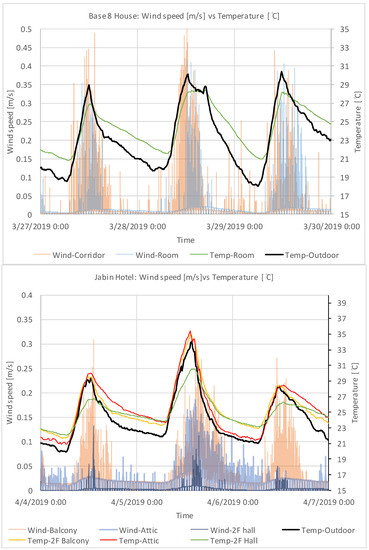
Figure 7.
Indoor wind speed and temperature.

Table 9.
Surface temperature from of infrared thermography (with key maps).
5.2.1. Temperature Cross Section
For the Chung house, both the main hall and bedroom have lower temperatures during the daytime and higher temperatures during the night compared to the outdoor temperature. The temperature in the bedroom is higher than in the main hall during the daytime, which may be due to the exposed ground’s cooling effect in the main hall. The trend is similar to that of the long-term measurement data (Figure 6).
For the Base 8 house, the temperature of the living room is 2 °C lower during the hottest part of the day and 2 °C higher during the coldest part of the day compared to that of the outdoor environment. The attic has significant heat accumulation from solar radiation. This temperature is almost 10 °C warmer than the outdoor temperature. Interestingly, without sun, the temperature in the attic can drop below that of the crawl space at the coldest part of the day, which is approximately 6 a.m. The crawl space can reach 4 °C below the temperature of the living room during the hottest part of the day (approximately 2 p.m.) and 1 °C below that of the coldest part of the day (in the early morning at approximately 6 a.m.). However, even during the coldest part of the day, the crawl space temperature is still 1 to 2 °C greater than the outdoor temperature. The similarity in the room temperatures between the living room and corridor reflects the characteristics of an open plan house.
For the Jabin hotel during the daytime, the temperatures of the back building attic and second-floor balcony are nearly the same. Their trends are similar to the outdoor temperature fluctuations with a difference of less than 1 °C. After sunset, the temperature of the balcony fluctuates similarly to the other second-floor spaces, while that of the attic still follows the outdoor trend but decreases more slowly. Essentially, the attic does not have solar radiation heat accumulation, unlike Base 8 house. The second-floor perimeter room, sitting hall, and Japanese room always share the same trend in temperature fluctuation. Due to the exterior wall, the perimeter room has a slightly higher temperature (<1 °C) than the other two spaces. This group has approximately half the scale of the day–night temperature fluctuation of the outdoor environment compared to the first group.
The front building corridor and back building first-floor stair hall have the same temperature fluctuation trends. Only the front building corridor is 1 °C higher due to solar radiation passing through the roof and dormer. This group has the mildest temperature fluctuation while registering on the high side of the outdoor temperature range.
Notably, the ground exposure has a strong effect on regulating the temperature range of the front building corridor and back building first-floor stair hall. On cold nights, the temperatures can reach as high as 4 °C above the outdoor temperature or 2 °C above the indoor temperatures of the back building second floor. On sunny and hot days, the temperatures can be 5 to 7 °C lower than the outdoor temperatures or 4 °C below the indoor temperatures of the back building second floor. Spaces in the ground and second floors of the Jabin hotel have different thermal environments.
5.2.2. Relative Humidity
With ground exposure, the main hall of the Chung house has a high relative humidity, mostly ranging from 75% to 85%. However, the bedroom, with an elevated bed deck blocking ground moisture, is much drier and more sensitive to outdoor relative humidity. The relative humidity can be 5% below that of the main hall on sunny days (Figure 6).
The living space of the Base 8 house has an elevated floor. This area is significantly drier than that of the Chung house. During the daytime, the difference can easily reach 7%. During the nighttime, however, the difference is reduced to less than 3%. Due to heat accumulation, the attic is even drier than the living spaces. The difference can reach greater than 20% in the daytime and 10% at nighttime. The crawl space is greatly influenced by ground moisture. The relative humidity is constantly above 80% and can sometimes reach as high as 90%. The difference in RHs between the crawl space and attic can commonly reach 40% in the daytime and 15% at night.
The living space of the Jabin hotel can be divided into two groups based on behavior: the ground floor and second floor. Heavily influenced by ground moisture, the spaces on the ground floor have narrow relative humidity fluctuations and high relative humidity values. The relative humidity of the well-shaded stair hall of the back building has a similar range to that of the main hall in the Chung house. The corridor of the front building, with the residual effect of radiant heat accumulation from the roof and dormer, is approximately 5% lower in relative humidity at night. The second-floor living spaces have a similar trend of relative humidity fluctuations to that of the Base 8 house; however, the relative humidity value is 2% to 3% higher at night due to the larger thermal mass of the Jabin hotel.
In summary, the Chung house is the wettest. The Base 8 house is driest, and yet, the relative humidity fluctuations are strongly influenced by the outdoor environment. The Jabin hotel’s performance is between the two.
5.2.3. Infrared Thermography
Thermography was performed on 8 January 2018 and 4 February 2019. Both days were sunny days. The outdoor temperatures ranged from 25 to 36 °C on 1 August 2018 and 17 to 26 °C on 2 April 2019 (Table 9).
For the Chung house, the hottest surface temperature occurred in the afternoon during summer but showed no clear trend in the spring. The surface temperatures of the north and south elevations are 4 to 6 °C higher in spring and 6 to 10 °C higher in summer compared to the surface temperatures of the indoor spaces. The surface temperatures of the roof and exterior sheds are 16 to 20 °C higher in spring and 20 to 30 °C higher in summer compared to the surface temperatures of the indoor spaces.
For the Base 8 house, the hottest surface temperature again occurs in the afternoon during summer but shows no clear trend in the spring. In the morning, the surface temperatures of the eastern elevation are approximately 30 °C higher in spring and 15 °C higher in summer compared to the surface temperatures of the indoor spaces. The surface temperatures of the roof and exterior sheds (front porch) are 25 to 45 °C higher in the morning in spring and 25 to 40 °C higher in the afternoon in summer compared to the surface temperatures of the indoor spaces at the same times. The surface temperatures of the ceiling are approximately 4 °C higher in the afternoon in spring and 25 to 40 °C higher in summer compared to the surface temperatures of the indoor spaces. The thermal graph measurements of the ceiling (a) and under the porch surface (d) also indicate the effectiveness of the attic as a heat flow barrier. The temperature difference between these areas reached 10 °C in both summer and spring.
For the Jabin hotel, there is no clear time period in which the hottest surface temperature occurs. The surface temperatures of the eastern and southern elevations are 8 to 10 °C higher than the surface temperatures of the indoor spaces in both spring and summer. The surface temperatures of the back building roof are approximately 8 °C higher in the afternoon in spring and 30 °C higher in summer compared to the surface temperatures of the indoor spaces. The surface temperatures of the ceiling are approximately the same as that of the other indoor surfaces. The surface temperatures of the indoor ground are approximately 2 to 4 °C lower than that of the other indoor surfaces.
For cross comparison, in the morning, the Base 8 house northern elevation and the Jabin hotel east elevation in summer and the Base 8 house and Jabin hotel east elevations in the spring have the highest surface temperatures of the respective buildings. Both of the buildings are exposed to an open field. In the afternoon, the Base 8 house western elevation and Jabin hotel southern, eastern, and northern elevations have the highest surface temperatures in the summer. In the spring, the Base 8 house northern and eastern elevations and the Jabin hotel eastern elevation (cloudy at the time of measurement) have the highest surface temperatures of the respective buildings. In the early evening in summer, the Base 8 house western elevation has the highest surface temperature, and there is no large difference seen in spring. Among the three buildings, the Chung house has the smallest indoor-to-outdoor surface temperature difference.
The comparison shows a strong influence of the sun’s presence and position to the temperature increase of the exterior wall surfaces, both outside and inside. It points to the importance of sun shading or space buffering mechanism in the summer in climate-responsive design.
5.2.4. Indoor Air Movement Measurements
Two batches of indoor wind pattern monitoring were conducted between 20 March 2019 and 18 April 2019. First, the anemometers were set up in the Base 8 house corridor and living room and then moved to the Jabin hotel and installed on the second-floor balcony, in the attic (by the window vent) and in the sitting area (by the grand stairs). The anemometers were all accompanied by HOBO sensors for synchronized wind/temperature/RH recordings (Figure 7).
The indoor air movement in the Base 8 house was recorded between 21 March 2019 and 2 April 2019. The ambient outdoor air temperatures ranged from 16 to 33 °C outdoors and from 18 to 31 °C indoors. The air velocity increased as the ambient temperature increased in the morning. The peak velocity of the indoor air movement mostly occurred when the outdoor ambient temperature reached a peak in the early afternoon. The steeper the outdoor ambient temperature climbs, the narrower the period in which the indoor air movement occurs. The measured spot in the living room registered a higher wind velocity than that in the corridor on cloudy days when the day-night temperature difference was less significant. The registered velocity of air movement is mostly less than 0.5 m/s, with the average wind speed (discounting v < 0.05 m/s) at approximately 0.1 m/s. When cross-examined with the temperature/RH records, it was also found that the day-to-night continuous windy period coexists with the presence of a daytime high relative humidity plateau, which implies a stable outdoor environment on cloudy days. Nighttime air movement occurs only on cloudy days with small day-to-night temperature differences. On sunny days, there were high day-to-night temperature shifts and relative humidity fluctuations, and little nighttime ventilation was observed. The wind direction is mostly from north in the corridor with side windows facing north and from north-west in the living room with a bay window on the west side. This finding indicates that the air flow path is from the side windows of the corridor to the living room, and then, the air flow exits through the bay windows.
The indoor air movement in the Jabin hotel was recorded between 5 April 2019 and 17 April 2019. The ambient air temperatures ranged from 19 to 38 °C outdoor, from 22 to 33 °C in the second-floor sitting hall and from 22 to 38 °C in the attic and second-floor balcony of the back building.
On the balcony, the air velocity increases as the ambient temperature increases. The peak velocity of the indoor air movement occurs mostly when the outdoor ambient temperature reaches its peak in the early afternoon. The steeper the outdoor ambient temperature climbs, the narrower the period in which the indoor air movement occurs. The registered velocity of air movement is mostly less than 0.4 m/s, with average wind speed at approximately 0.07 m/s. When cross-examined with the temperature/RH records, it was found that the day-to-night continuous windy period coexists with the presence of a daytime high relative humidity plateau and a low day-to-night temperature difference, which implies a stable outdoor environment on cloudy days. The nighttime air movement occurs only on cloudy days. On sunny days, when there is a high degree of day-to-night temperature shift and relative humidity fluctuations, little nighttime air movement was observed. The wind blows mostly from the northwestern direction, whereas the exterior opening of the balcony is south-facing. The air movement pattern on the balcony of the Jabin hotel’s rear building is similar to that of the Base 8 house, with only a minor decrease in intensity.
There are small yet significant differences between the air movement at the measurement spot in the attic and that on the second-floor balcony: (1) On several occasions, there was little air movement in the attic when air movement was clearly detected on the balcony. Air movement occurs often when the day-to-night temperature is greater than 8 °C on sunny days. (2) On other occasions, the peak wind speed will suddenly occur in the attic, while simultaneously, on the balcony, the wind increases gradually before reaching the peak. It is interesting that the peak wind speeds of the two locations occur simultaneously despite very different air movement patterns, implying that the air movement may be induced by an outside influence but barred by a certain velocity threshold. The registered wind velocity in the attic is mostly less than 0.25 m/s, with an average wind speed of just above 0.05 m/s. The wind runs from north to west, which is similar to that on the balcony. These records indicate that the attic of the Jabin hotel is a well-ventilated space.
Although connected to the balcony with two fully open walkways, the sitting area on the second floor of the rear building showed very small air movement. It basically followed the balcony wind pattern; however, the wind velocity mostly peaked at less than 0.05 m/s, with very few exceptions when the wind speed reached 0.1 m/s. There is no clear wind direction. Even with little air movement, the temperature of the space can still reach 4 °C lower during the hottest part of the day and 4 °C higher during the coldest part of the night compared to the outside ambient temperature, which is due to the heavy buffer and heat storage effects of the rear building’s spatial compartments.
6. Conclusions
The findings of this study are summarized in the followings: (1) Differences between the three houses and their foreign counterparts; (2) Building design and use pattern; (3) Longevity of building materials; (4) Characteristics of the three thermal environments; and (5) Performance appraisal of specific climate-responsive design strategies; (6) Applicability to sustainable building design.
- Construction material of the Chinese style building (thatch roof, weed/bamboo woven wall) are not the same as those from its home land (adobe or brick wall, tile roof). By changing the material to a lightweight system and choosing tighter building envelope, the Chinese-style house has created characteristics of thermal performance different from its counterparts in China [1,2,3,4]. Applying similar constructions, the difference in thermal performance [5,6,7] between the Japanese-style house and its counterparts in Japan is induced by the differences in regional climates. The indigenous mixed-style house has a strong perimeter-core spatial arrangement. The perimeter rooms perform similar to the Japanese-style house. The core spaces perform similar to the Chinese-style house.
- Building characteristics are strongly associated with the building’s use pattern. The Chung house is tightly wrapped for protection against the elements. There is little daylight inside the Chung house. This house was a farmhouse. The occupants worked outdoors during the day. Natural light is hardly useful. The Base 8 house has large glass windows and an open floor plan. The air and daylight can easily circulate in this house. This house was built for institutional workers. Their family members spent most of the day indoors. The Jabin hotel has well-circulated walkways in the core and heavily partitioned bedrooms with windows along the perimeter. The interior layout was designed for a large number of dwellers who need privacy.
- All houses were intact and in fair condition during the survey. The only major original building materials being replaced are the roof tiles. The thatched roof is, however, quite durable. Although moisture accumulation has caused problems locally on the weed or bamboo strip woven mud walls, minor repairs and material replacements can easily fix these issues.
- The three houses have different indoor thermal environment characteristics. The Jabin hotel strongly holds heat. The hotel has the mildest temperature fluctuations, largest peak temperature lag time, well-ventilated perimeter spaces, and a small amount of natural ventilation in its core. The Jabin hotel is comfortable for winter and spring but uncomfortable in summer.The Chung house strongly deflects heat. The house has the most humid environment, minimum daylight and natural ventilation indoors, and the lowest exterior surface temperature. The Chung house is comfortable in spring and summer but not comfortable in winter.In contrast, the Base 8 house is a moderate climate mediator. The house has the driest environment, largest temperature fluctuations, constant natural ventilation, and ample daylight in the living areas. The Base 8 house is also most susceptible to outside influence. The house provides moderate comfort (close to 50%) during all seasons.
- Key findings of the design strategies include: A) the window layout (Jabin hotel vs. Base 8 house) appears to have a strong impact on the effectiveness of indoor air movement. B) There are two types of attics: sealed and well-ventilated. The thermal environments of these attic types are distinctively different. The actual impact of these two attic design types on the buildings remains uncertain. C) The different effects of ground exposure versus elevated floors were well observed. D) The thatched roof shows goof thermal insulations property. The weed or bamboo woven walls with mud cover are more suspicious to heat flux induced by direct solar radiation.
- From the aspect of construction material usage, all three houses are zero- or negative- carbon buildings. They are mainly built with organic material. The time the material in use is longer than the time they need to regrow. Furthermore, the thermal environment of the three houses shows that a high percentage of thermal comfort in different usage patterns can be achieved through different climate-responsive design strategies. The findings indicate that it is probable to use these environmentally friendly design strategies to create good quality buildings. It is especially relevant since these three buildings represent building types for three key lifestyles in this region.
Author Contributions
Conceptualization, Y.-S.C.; methodology, Y.-S.C. and J.S.E.; formal analysis, Y.-S.C. and J.S.E.; investigation, J.S.E.; resources, Y.-S.C.; data curation, Y.-S.C. and J.S.E.; writing, Y.-S.C.; visualization, Y.-S.C. and J.S.E.; project administration, Y.-S.C. and J.S.E.; funding acquisition, Y.-S.C.
Funding
This research was funded by the Taiwan Ministry of Science and Technology and by the Taiwan Ministry of Education.
Acknowledgments
The authors are grateful to the ISAAC (Integrating Simulation and Analysis for Architectural Complexity) Lab at the National Taiwan University of Science and Technology (NTUST). Its long-term commitment to vernacular spatial study and rural community engagement makes this research possible.
Conflicts of Interest
The authors declare no conflict of interest.
References
- Borong, L.; Gang, T.; Peng, W.; Ling, S.; Yingxin, Z.; Guangkui, Z. Study on the thermal performance of the Chinese traditional vernacular dwellings in Summer. Energy Build. 2004, 36, 73–79. [Google Scholar] [CrossRef]
- Du, X.; Bokel, R.; van den Dobbelsteen, A. Building microclimate and summer thermal comfort in free-running buildings with diverse spaces: A Chinese vernacular house case. Build. Environ. 2014, 82, 215–227. [Google Scholar] [CrossRef]
- Gou, S.; Li, Z.; Zhao, Q.; Nik, V.; Scartezzini, J. Climate responsive strategies of traditional dwellings located in an ancient village in hot summer and cold winter region of China. Build. Environ. 2015, 86, 151–165. [Google Scholar] [CrossRef]
- Xu, H.; Huang, Q.; Liu, G.; Zhang, Q. A quantitative study of the climate-responsive design strategies of ancient timber-frame halls in northern China based on field measurements. Energy Build. 2016, 133, 306–320. [Google Scholar] [CrossRef]
- Yoshino, H.; Hasegawa, K.; Matsumoto, S. Passive cooling effect of traditional Japanese building’s features. Manag. Environ. Qual. 2007, 18, 578–590. [Google Scholar] [CrossRef]
- Ooka, R. Field study on sustainable indoor climate design of a Japanese traditional folk house in cold climate area. Build. Environ. 2002, 37, 319–329. [Google Scholar] [CrossRef]
- Rijal, H.B.; Humphreys, M.; Nicol, F. Adaptive Thermal Comfort in Japanese Houses during the Summer Season: Behavioral Adaptation and the Effect of Humidity. Buildings 2015, 5, 1037–1054. [Google Scholar] [CrossRef]
- Cascone, S.; Rapisarda, R.; Cascone, D. Physical Properties of Straw Bales as a Construction Material: A Review. Sustainability 2019, 11, 3388. [Google Scholar] [CrossRef]
- Cantin, R.; Burgholzer, J.; Guarracino, G.; Moujalled, B.; Tamelikecht, S.; Royet, B.G. Field assessment of thermal behaviour of historical dwellings in France. Build. Environ. 2010, 45, 473–484. [Google Scholar] [CrossRef]
- Dili, A.S.; Naseer, M.A.; Varghese, T.Z. Passive control methods of Kerala traditional architecture for a comfortable indoor environment: A comparative investigation during winter and summer. Build. Environ. 2010, 45, 1134–1143. [Google Scholar] [CrossRef]
- Manu, S.; Brager, G.; Rawal, R.; Geronazzo, A.; Kumar, D. Performance evaluation of climate responsive buildings in India—Case studies from cooling dominated climate zones. Build. Environ. 2019, 148, 136–156. [Google Scholar] [CrossRef]
- Mohammadi, A.; Saghafi, M.R.; Tahbaz, M.; Nasrollahi, F. The study of climate-responsive solutions in traditional dwellings of Bushehr City in Southern Iran. J. Build. Eng. 2018, 16, 169–183. [Google Scholar] [CrossRef]
- Oikonomou, A.; Bougiatioti, F. Architectural structure and environmental performance of the traditional buildings in Florina, NW, Greece. Build. Environ. 2011, 46, 669–689. [Google Scholar] [CrossRef]
- Priya, R.; Sundarraja, M.; Radhakrishnan, S.; Vijayalakshmi, L. Solar passive techniques in the vernacular buildings of coastal regions in Nagapattinam, TamiNadu-India—A qualitative and quantitative analysis. Energy Build. 2012, 49, 50–61. [Google Scholar] [CrossRef]
- Canas, I.; Martin, S. Recovery of Spanish vernacular construction as a model of bioclimatic architecture. Build. Environ. 2004, 39, 1477–1495. [Google Scholar] [CrossRef]
- Kim, T.J.; Park, J.S. Natural ventilation with traditional Korean opening in contemporary house. Build. Environ. 2010, 45, 51–57. [Google Scholar] [CrossRef]
- Lotfabadi, P.; Hançer, P. A Comparative Study of Traditional and Contemporary Building Envelope Construction Techniques in Terms of Thermal Comfort and Energy Efficacy in Hot and Humid Climates. Sustainability 2019, 11, 3582. [Google Scholar] [CrossRef]
- Shaviv, E.; Yezioro, A.; Capeluto, I.G. Thermal mass and night ventilation as passive cooling design strategy. Renew. Energy 2001, 24, 445–452. [Google Scholar] [CrossRef]
- Soleymanpour, R.; Parsaee, N.; Banaei, M. Climate Comfort Comparison of Vernacular and Contemporary Houses of Iran. Procedia Soc. Behav. Sci. 2015, 201, 49–61. [Google Scholar] [CrossRef]
- Al Tawayha, F.; Braganca, L.; Mateus, R. Contribution of the Vernacular Architecture to the Sustainability: A Comparative Study between the Contemporary Areas and the Old Quarter of a Mediterranean City. Sustainability 2019, 11, 896. [Google Scholar] [CrossRef]
- Toe, D.H.C.; Kubota, T. Comparative assessment of vernacular passive cooling techniques for improving indoor thermal comfort of modern terraced houses in hot-humid climate of Malaysia. Sol. Energy 2015, 114, 229–258. [Google Scholar] [CrossRef]
- Barbero-Barrera, M.M.; Gil-Crespo, I.J.; Maldonado-Ramos, L. Historical development and environment adaptation of the traditional cave-dwellings in Tajuna’s valley, Madrid, Spain. Build. Environ. 2014, 82, 536–545. [Google Scholar] [CrossRef]
- Bodach, S.; Lang, W.; Hamhaber, J. Climate responsive building design strategies of vernacular architecture in Nepal. Energy Build. 2014, 81, 227–242. [Google Scholar] [CrossRef]
- Indraganti, M. Understanding the climate sensitive architecture of Marikal, a village in Telangana region in Andhra Pradesh, India. Build. Environ. 2010, 45, 2709–2722. [Google Scholar] [CrossRef]
- Nguyen, A.T.; Tran, Q.B.; Tran, D.Q.; Reiter, S. An investigation on climate responsive design strategies of vernacular housing in Vietnam. Build. Environ. 2011, 46, 2088–2106. [Google Scholar] [CrossRef]
- Philokyprou, M.; Michael, A.; Malaktou, E.; Savvides, A. Environmentally responsive design in Eastern Mediterranean. The case of vernacular architecture in the coastal, lowland and mountainous regions of Cyprus. Build. Environ. 2017, 111, 91–109. [Google Scholar] [CrossRef]
- Sahebzadeh, S.; Kamelnia, H.; Baghbani, A. Sustainability Features of Iran’s Vernacular Architecture: A Comparative Study between the Architecture of Hot–Arid and Hot–Arid–Windy Regions. Sustainability 2017, 9, 749. [Google Scholar] [CrossRef]
- Elvin, M.; Liu, T.J. Han Migration and the Settlement of Taiwan: The Onset of Environmental Change. In Sediment of Time: Environment and Society in Chinese History; Cambridge University Press: New York, NY, USA, 1998. [Google Scholar]
- Liao, P.H.; Wang, D.W. (Eds.) Taiwan under Japanese Colonial Rule, 1895–1945: History, Culture, Memory. In Studies of the Weatherhead East Asian Institute, Columbia University; Columbia University Press: New York, NY, USA, 2006. [Google Scholar]
- Morris, A.D. (Ed.) Japanese Taiwan: Colonial Rule and its Contested Legacy. In SOAS Studies in Modern and Contemporary Japan; Bloomsbury Academic: New York, NY, USA, 2015. [Google Scholar]
- Zhai, Z.; Previtali, J.M. Ancient vernacular architecture: Characteristics categorization and energy performance evaluation. Energy Build. 2010, 42, 357–365. [Google Scholar] [CrossRef]
- Chiou, S.C.; Krishnamurti, R. Example Taiwanese traditional houses. Environ. Plan. B Plan. Des. 1996, 23, 191–216. [Google Scholar] [CrossRef]
- Knapp, R.G. China’s old dwellings; University of Hawai’i Press: Honolulu, HI, USA, 2000. [Google Scholar]
- Ozaki, R.; Lewis, J.R. Boundaries and the meaning of social space: A study of Japanese house plans. Environ. Plan. D Soc. Space 2006, 24, 91–104. [Google Scholar] [CrossRef]
- Smith, R.A. Comfort, Room Use and Economy of Means in the Japanese House. Build. Environ. 1981, 16, 167–175. [Google Scholar] [CrossRef]
- Chiou, Y.S.; Hsieh, Y.H.; Huang, Y.H. Reinventing the historic townscape—A Guanshan Story. In Proceedings of the 37th International Conference on Passive and Low Energy Architecture (PLEA 2017), Edinburgh, UK, 3–5 July 2017; pp. 4477–4484. [Google Scholar]
- Academic Sinica. Taiwan Historic Maps. Available online: http://gissrv4.sinica.edu.tw/gis/twhgis.aspx (accessed on 3 June 2019).
- Taiwan Central Weather Bureau. Taiwan Historic Weather Database. Available online: https://e-service.cwb.gov.tw/HistoryDataQuery/index.jsp (accessed on 3 June 2019).
- Machiya: A Typology of Japanese Townhouses. In Proceedings of the 1st TTCL Annual Symposium, Melaka, Malaysia, May 2011; pp. 44–49.
- Kubota, T.; Zakaria, M.A.; Abe, S.; Toe, D.H.C. Thermal functions of internal courtyards in traditional Chinese shophouses in the hot-humid climate of Malaysia. Build. Environ. 2017, 112, 115–131. [Google Scholar] [CrossRef]
- Huang, S.L.; Kuo, C. The new order of dwelling as morphological restructuring of Taiwan shophouse, with a case study on Tainan. Urban Form at the Edge. In Proceedings of the International Seminar on Urban Form (ISUF2013) 1, Brisbane, Australia, 17–20 July 2013; pp. 129–135. [Google Scholar]
- Kirimtat, A.; Krejcar, O. A review of infrared thermography for the investigation of building envelopes: Advances and prospects. Energy Build. 2018, 176, 390–406. [Google Scholar] [CrossRef]
- ASHRAE. ANSI/ASHRAE Standard 55-2017, Thermal Environmental Conditions for Human Occupancy; ASHRAE, Inc.: Atlanta, GA, USA, 2017. [Google Scholar]
© 2019 by the authors. Licensee MDPI, Basel, Switzerland. This article is an open access article distributed under the terms and conditions of the Creative Commons Attribution (CC BY) license (http://creativecommons.org/licenses/by/4.0/).
